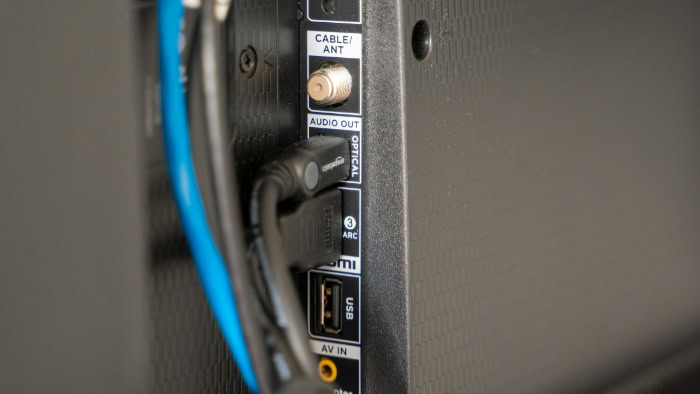HDMI ARC vs. Optical Audio: Know the Difference

Achieving the perfect audio experience in your home theater setup depends heavily on the connection you choose to link your TV to external speakers or sound systems. With HDMI ARC (Audio Return Channel) and Optical Audio emerging as the leading contenders, deciding between the two can feel like a balancing act of performance, compatibility, and convenience.
HDMI ARC offers cutting-edge features, supporting advanced audio formats and reducing cable clutter, while Optical Audio provides a straightforward, dependable option, especially for older devices. Each has its own strengths and trade-offs, catering to different priorities like sound quality, ease of use, and future-proofing your setup.
Technical Specifications and Audio Capabilities
Audio performance hinges on the technology behind the connection, making it crucial to examine the technical capabilities of HDMI ARC and Optical Audio. Both interfaces are designed to transmit sound from one device to another, but the type of audio formats they support and the bandwidth they offer reveal some critical distinctions.
These differences influence the quality, depth, and potential of your home entertainment system's sound output.
Bandwidth and Supported Formats
HDMI ARC uses the HDMI interface to transfer audio data, benefiting from higher bandwidth and compatibility with advanced audio formats. Its ability to support uncompressed formats like PCM enables it to deliver richer, more dynamic sound.
Additionally, HDMI ARC can handle object-based surround sound technologies such as Dolby Atmos and DTS:X, which are essential for creating an immersive, three-dimensional audio experience. This makes HDMI ARC well-suited for modern home theater setups where sound quality is as important as visual fidelity.
Optical Audio, on the other hand, relies on a fiber-optic cable to transmit sound in compressed formats. It supports surround sound technologies such as Dolby Digital and DTS 5.1, which are sufficient for many users but lack the high-resolution quality of newer formats.
While it competently handles multichannel audio up to 5.1, its bandwidth is considerably smaller, preventing it from carrying advanced uncompressed or object-based formats. For most basic setups and legacy equipment, Optical Audio remains a practical option, though it is not equipped to match the capabilities of HDMI ARC in delivering modern, theater-grade audio.
Audio Quality Comparison
The difference in bandwidth between HDMI ARC and Optical Audio has a direct impact on audio quality. HDMI ARC’s ability to transmit uncompressed audio means it can deliver a more dynamic range and greater detail in sound design.
Whether you're listening to a movie soundtrack or live music performance, the depth and clarity provided by uncompressed audio elevate the overall experience. Additionally, support for object-based audio formats such as Dolby Atmos enables sounds to be placed and moved with precision, creating a more engaging and lifelike soundstage.
Optical Audio, while reliable, faces limitations when it comes to audio quality. Its lack of support for uncompressed formats restricts the overall dynamic range, and it cannot handle more than 2-channel PCM for stereo music.
As a result, users may notice a narrower soundstage and reduced clarity in nuanced audio. Optical Audio also falls short in delivering seamless surround sound for those seeking the latest advancements in audio experiences, making it best suited for setups where simplicity and compatibility with older devices take precedence over maximum fidelity.
Compatibility and Device Integration

The success of any connection standard depends not only on its technical capabilities but also on how well it integrates with a variety of devices and user setups. HDMI ARC and Optical Audio differ significantly in terms of device compatibility, making your specific equipment and setup requirements an important consideration.
Device Support
HDMI ARC is designed with modern technology in mind and is widely supported by most newer TVs, soundbars, AV receivers, and streaming devices. Its ability to carry audio over an HDMI cable streamlines home theater connections, supporting two-way communication between devices.
For HDMI ARC to function, devices must support HDMI-CEC (Consumer Electronics Control), which allows equipment like TVs and soundbars to communicate and operate together with a single remote. Most high-end and mid-range televisions and audio systems manufactured in recent years are compatible with this feature, making HDMI ARC a standard choice for contemporary setups prioritizing simplicity and advanced performance.
Optical Audio, in contrast, has been a longstanding audio connection standard and is often found in older devices. It provides a reliable way to connect gaming consoles, older TVs, CD players, and legacy sound systems that may not have HDMI ports.
While Optical Audio does not offer the same advanced capabilities as HDMI ARC, its widespread presence in older technology gives it an edge when working with legacy equipment. For those who want a simple connection to an aging sound system or devices without HDMI support, Optical Audio remains a dependable option.
Configuration Requirements
Setting up HDMI ARC requires more than just plugging in a cable. HDMI-CEC must be enabled on connected devices to allow communication between components.
This feature unifies control of multiple devices, enabling users to adjust the soundbar or AV receiver volume and power through their TV remote. However, proper configuration depends on the compatibility and implementation of HDMI-CEC across all devices in the setup.
In some cases, users may need to navigate device settings or troubleshoot mismatches in compatibility, which can add an extra layer of complexity for first-time users.
Optical Audio takes a more straightforward approach, as it does not rely on advanced communication protocols like HDMI-CEC. A simple connection between the optical output on one device and the input on the other allows for immediate audio transmission.
Users only need to select the appropriate input source on the receiving device, making it a nearly plug-and-play solution. For basic setups or those involving older equipment, the simplicity of Optical Audio eliminates the need for advanced configuration, appealing to those who prioritize ease of use.
Physical Setup and User Experience

Setting up audio connections for a home entertainment system involves more than just choosing between HDMI ARC and Optical Audio. The physical setup and user experience can significantly impact satisfaction, particularly in terms of cable management and signal reliability.
Cable Management
HDMI ARC simplifies cable management by transmitting both audio and video signals through a single HDMI cable. It eliminates the need for additional connections when setting up a soundbar or AV receiver, which is particularly advantageous for minimizing clutter and maintaining a cleaner look.
This streamlined setup is ideal for modern entertainment centers, as it reduces the number of cables required to connect devices, an important factor in today’s minimalist home theater designs.
Optical Audio, due to its dedicated function, often requires a separate cable for audio alongside other connections like HDMI or component cables for video. While optical cables themselves are relatively thin and easy to handle, the need for multiple wires can complicate the setup and create more cable clutter.
For those striving for neatness or who are working with limited space, the additional cabling may detract from the overall aesthetic appeal of the system.
Interference and Signal Integrity
The construction and technology behind optical cables provide a notable advantage in terms of signal integrity. Optical Audio uses fiber-optic technology to transmit sound as pulses of light, avoiding the electrical interference that can affect traditional copper wiring.
This makes it particularly reliable in environments with high electromagnetic activity, as the signal remains unaffected by nearby power sources or other electronic devices. The stability of optical signals contributes to a consistent listening experience, even in less-than-ideal conditions.
HDMI ARC, while versatile, is more vulnerable to signal degradation over long cable runs. Its copper-based design can be affected by electromagnetic interference, especially in crowded or complex setups with multiple devices located close to each other.
For installations requiring longer cables, users may notice reduced signal quality or encounter challenges maintaining reliable connections. Investing in high-quality HDMI cables can mitigate some of these issues, but they may come at a higher cost compared to standard optical cables.
Cost and Practical Considerations

The decision between HDMI ARC and Optical Audio often comes down to cost and practicality. While both options provide reliable audio transmission, differences in pricing, accessibility, and long-term value play a significant role in determining which is better suited for your specific needs.
Pricing and Accessibility
HDMI cables are widely available and generally affordable, making HDMI ARC an accessible solution for most users. Basic HDMI cables, which are sufficient for many home setups, are priced competitively.
However, for longer cable runs or setups requiring higher bandwidth, higher-quality HDMI cables may be necessary, which can result in a price increase. Additionally, devices must support HDMI ARC and HDMI-CEC functionality to fully utilize its features, potentially leading to hidden expenses if upgrades to compatible equipment are required.
Optical cables can also be purchased at reasonable prices, but high-quality options may cost more than standard HDMI cables. While some users prefer investing in premium optical cables for improved durability or signal integrity, Optical Audio generally avoids the compatibility issues associated with HDMI ARC.
Devices with optical audio ports are still widely available, especially among older hardware, making Optical Audio a cost-effective choice for those with legacy setups. Users building basic systems may find this option particularly appealing, as it avoids the need for additional features like HDMI-CEC.
Long-Term Value
HDMI ARC offers significant advantages for users seeking a future-proof solution. Its ability to support advanced, uncompressed audio formats and surround sound technologies like Dolby Atmos makes it a powerful choice for those planning to upgrade their devices over time.
As audio technology continues to evolve, HDMI ARC-equipped systems are better positioned to accommodate these advancements. The versatility of HDMI ARC extends beyond audio, as it can also transmit video when necessary, further enhancing its long-term practicality.
Optical Audio, while reliable for current setups, lacks the adaptability of HDMI ARC. Its inability to handle uncompressed formats or advanced surround sound technologies limits its future utility.
For users who prefer a static, budget-friendly system without plans for frequent upgrades, Optical Audio remains a practical choice. The simplicity and compatibility with older devices make it a dependable option for maintaining an existing system without additional investments in newer technologies.
Conclusion
Selecting between HDMI ARC and Optical Audio depends on the balance of priorities such as audio quality, device compatibility, ease of setup, and long-term needs. HDMI ARC stands out with its support for advanced audio formats like Dolby Atmos and uncompressed PCM, making it a strong choice for modern setups and users who value immersive, high-quality sound.
Its single-cable functionality and future-forward capabilities also make it an attractive option for those planning to upgrade their systems over time.
Optical Audio, on the other hand, remains a reliable solution for those seeking simplicity or working with older devices. Its resistance to electrical interference and straightforward plug-and-play setup make it especially appealing for basic or legacy systems, even if it lacks support for more advanced audio technologies.
Each connection method has its strengths, and the right choice depends on your current equipment, desired audio performance, and plans for future upgrades.


